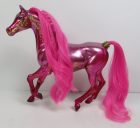Embrace Imperfection in Your Art
I've been teaching arts and crafts classes at the library for several years. It's one of my favorite things to do! One of the biggest challenges is convincing adults that yes, they are creative, and if something isn't perfect, that's ok. It really is.
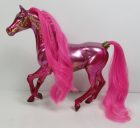 When I was a kid, I colored horses in my coloring books magenta. Horses are clearly not magenta naturally, but that's the color I wanted them to be, so that's the color they were. That kind of confidence in my artistic vision disappeared as I got older. I got caught up in whether something was "right" or not. It's taken me many years to get here but now I accept that failure is not the end of the road.
When I was a kid, I colored horses in my coloring books magenta. Horses are clearly not magenta naturally, but that's the color I wanted them to be, so that's the color they were. That kind of confidence in my artistic vision disappeared as I got older. I got caught up in whether something was "right" or not. It's taken me many years to get here but now I accept that failure is not the end of the road.I've gathered some stories from my talented co-workers to show that it's okay to make a mistake (or lots of them), to learn from your mistake(s) and to apply that knowledge to future projects. Perseverance and the ability to laugh at yourself are key elements of creativity.
Bob Ross Used Oil Paints for a Reason –Artist 1
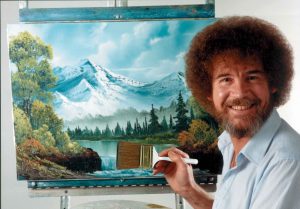 Last Halloween, I thought it would be fun to do a partner’s costume where my partner would be Bob Ross and I’d be one of his paintings. What’s the best way to get a Bob Ross painting? Follow along with Bob and paint one yourself, right? Of course!
Last Halloween, I thought it would be fun to do a partner’s costume where my partner would be Bob Ross and I’d be one of his paintings. What’s the best way to get a Bob Ross painting? Follow along with Bob and paint one yourself, right? Of course!Well, that’s what I did, except I decided to use acrylic paint instead of oil paint. As it turns out, that is not a great idea. Acrylic dries so much faster than oil paint. So all that beautiful blending and “happy little trees” were met with frustration and cursing as I tried to keep pace with Bob while my paint dried at lightning speed. The painting ended up all right, but I will definitely be using oil paint the next time around!
Sweaters, Sweaters and More Sweaters –Artist 2
Back in my early knitting days I knit multiple badly fitting sweaters. The first one I made was just gigantic. I wore it around the house anyway.
Shortly after that I knitted another sweater out of cotton instead of wool. It fit! So I wore it on a night out. Over the course of the evening it got longer, and wider and bigger. I didn't know that cotton stretches a lot and I should have taken that into account and made it smaller.
Despite these failures I was determined I could knit a sweater. So I stuck to smaller projects for a while and read a lot online about the qualities of different fibers and how to measure yourself for a sweater pattern. Eventually I made multiple, successful wool sweaters. I still don't think I'll ever make another cotton sweater though.
Start Small and Work Your Way Up –Artist 3
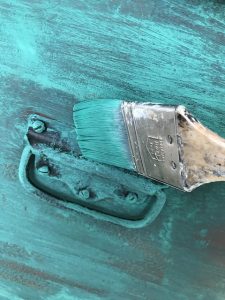 I love to create, but I procrastinate. Details can overwhelm me. I’ve learned that I have to jump into projects feet first and accept that the initial attempt will be awful. I’ve made jewelry that falls apart, sewn seams with less than a quarter inch allowance, and left furniture half painted for decades (no exaggeration), because I didn’t buy enough paint or bought the wrong kind.
I love to create, but I procrastinate. Details can overwhelm me. I’ve learned that I have to jump into projects feet first and accept that the initial attempt will be awful. I’ve made jewelry that falls apart, sewn seams with less than a quarter inch allowance, and left furniture half painted for decades (no exaggeration), because I didn’t buy enough paint or bought the wrong kind.I’m impatient and lazy and don’t like taking the time to build the necessary skills to do something well, but… I have to. Eventually I learned to choose simple projects with minimum tools and supplies, and then try to build up to the bigger projects.
Adults Should Play Too –Artist 4
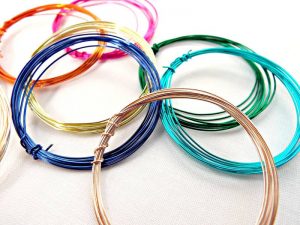 Teaching wirework, I’ve had to help people get over their fear of failure and embrace not being attached to a certain result. It is very difficult to get adults into the mindset of play. This is one of the reasons I never plan a design. We all make mistakes along the way, and what we do with those mistakes is where the creativity lies.
Teaching wirework, I’ve had to help people get over their fear of failure and embrace not being attached to a certain result. It is very difficult to get adults into the mindset of play. This is one of the reasons I never plan a design. We all make mistakes along the way, and what we do with those mistakes is where the creativity lies.I self-teach and experiment for a very long time before I resort to looking at a tutorial, because I don’t want someone else’s vision to be the foundation of mine. I refer to them to learn a process, but not to create a complete work. I don’t consider myself to be particularly creative, but I do have my own artistic voice in all of the making I do.
Failure – Knowledge – Motivation
These stories help reinforce what I've believed for a long time – creative failure can be constructive. Making mistakes leads to gaining knowledge, which leads to motivation and inspiration. So the next time that art or craft project doesn't turn out the way you want it to, figure out how you can do it better in the future. Hang on to your "failures," they're a great way to chart your progress and see how far you've come.
We're Here for You!
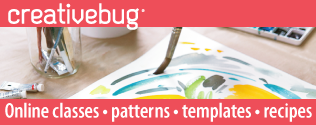 The library has tons of resources to help you learn new art and craft skills and techniques. If you're a visual learner, Creativebug is a great way to find quality videos without sifting through the crafty mess of YouTube. From quick 10 minute lessons to multipart classes, there's always something new to learn. You can use Creativebug for free with your library card!
The library has tons of resources to help you learn new art and craft skills and techniques. If you're a visual learner, Creativebug is a great way to find quality videos without sifting through the crafty mess of YouTube. From quick 10 minute lessons to multipart classes, there's always something new to learn. You can use Creativebug for free with your library card!If you prefer books and DVDs, fill out a Browsing Just for You form. Answer a few simple questions and our librarians will pick books from the Arts & Crafts Neighborhood and have them ready for you to pick up at curbside. Or come into the library and browse for yourself.
We also have a variety of Arts & Crafts kits that include the basic materials to get started. Check out a kit and try a new craft without spending a penny.












